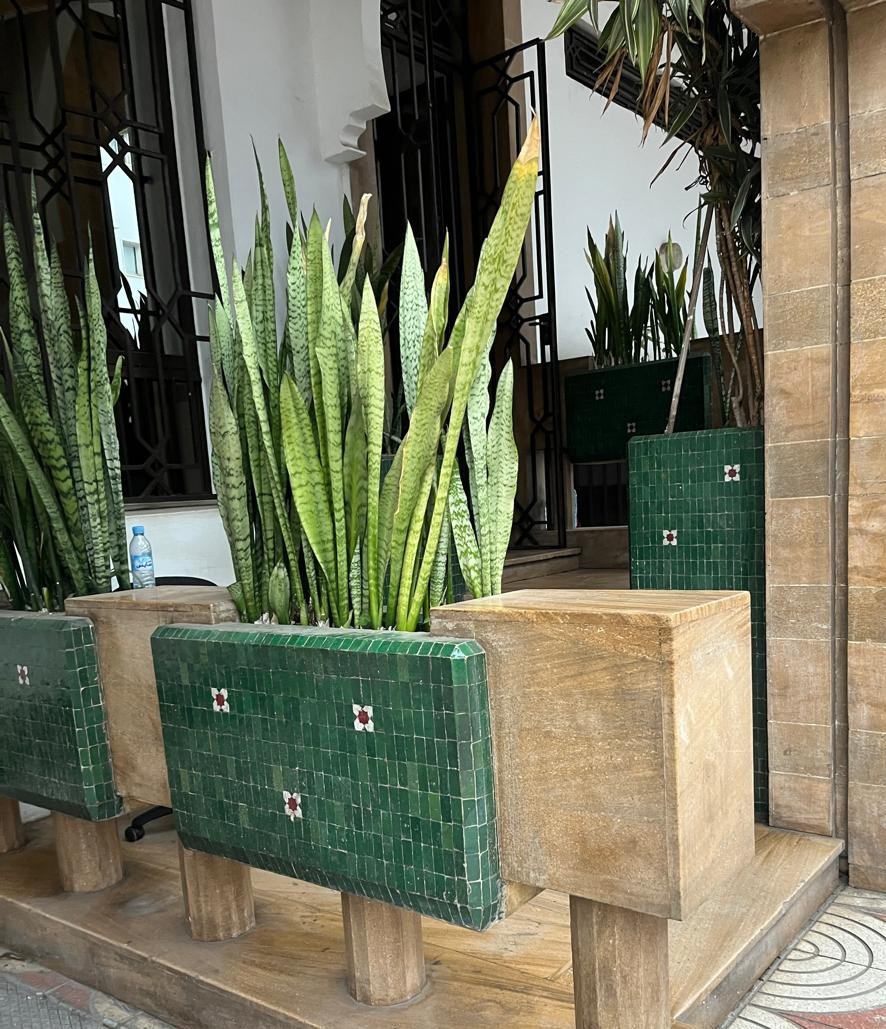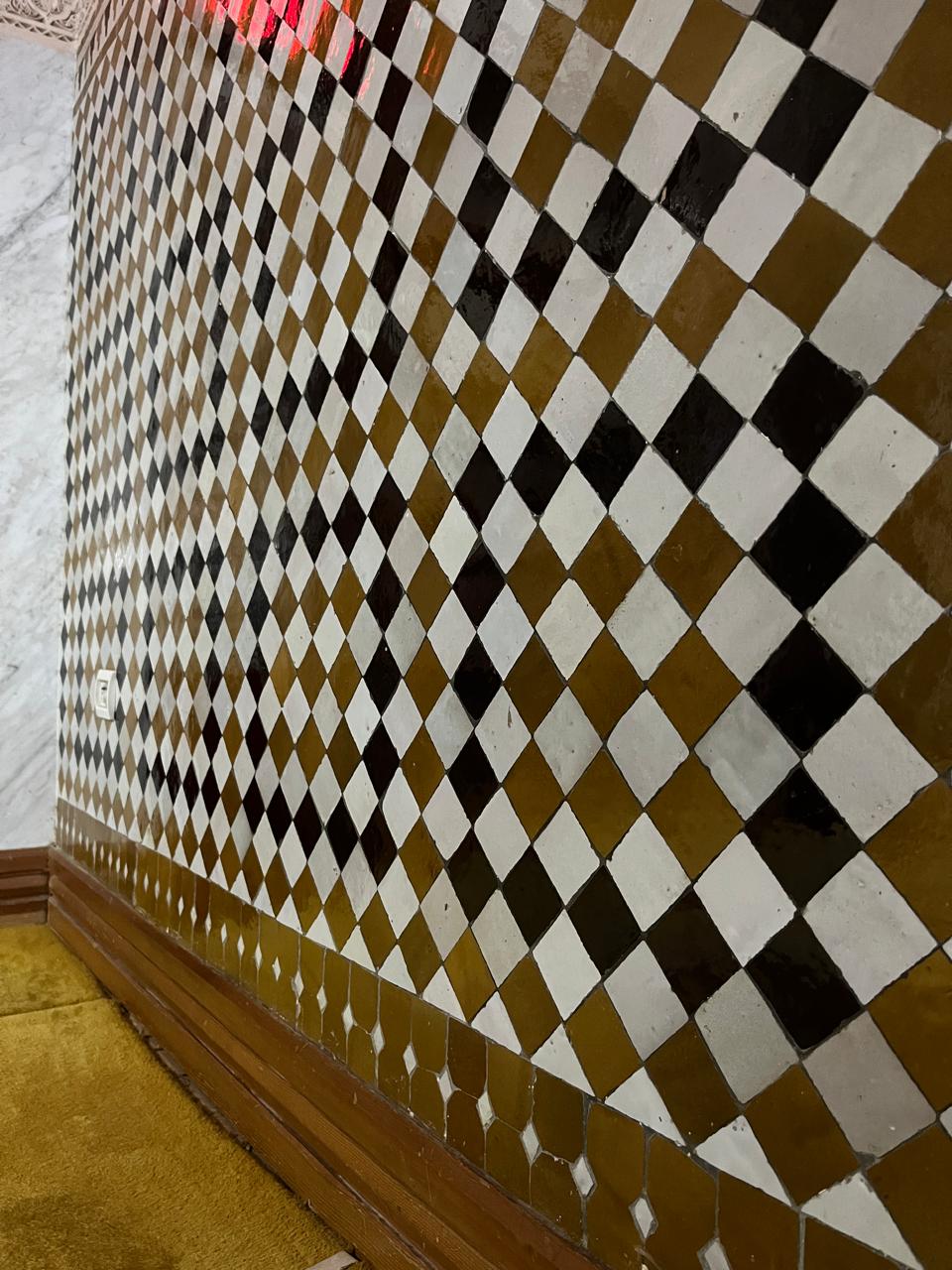The Use of Zellige in Architecture: The Different Ways Zellige is Used .
Zellige is a traditional mosaic technique that has been widely used around the world for centuries.
This technique is employed to beautify and decorate various types of buildings, including palaces, mosques, gardens, contemporary homes, and much more.
In this article, we will explore the different ways Zellige is used in both traditional and modern architecture.
-Gardens and Zellige: A Perfect Harmony:
In Morocco, gardens are considered an extension of the home. They are often designed as spaces for relaxation and leisure, where residents can enjoy the pleasant weather, rest, and entertain.
Zellige, a form of traditional Moroccan decorative art, is widely used in gardens to create unique and aesthetically pleasing design elements.
Zellige is also used to craft decorative features such as fountains, basins, boundary walls, benches, and tables. The intricate geometric and floral patterns of zellige blend beautifully with the greenery of the garden, adding a touch of elegance and sophistication to the outdoor space.
Zellige fountains are particularly popular in Moroccan gardens. These fountains are not only beautiful to look at, but they also serve the practical purpose of providing a water source for plants. The colorful zellige patterns bring joy and vibrancy to the space as well.
-Zellige Garden Walls and Benches: Beauty with Function:

Zellige-clad boundary walls are also a popular addition to Moroccan gardens. These walls provide privacy and security while adding a touch of beauty to the space. The intricate geometric patterns create a visually appealing effect that draws attention to the fence or wall.
Zellige benches are another common feature in Moroccan gardens. Often integrated into the natural landscape, these benches offer a comfortable place to sit and enjoy the garden. The geometric and floral motifs of the zellige add an element of beauty and elegance to the seating area.
Beyond its aesthetic appeal, zellige also offers practical benefits in Moroccan gardens. The glazed tiles are weather-resistant,
making them ideal for outdoor use without the risk of deterioration. Zellige is also easy to clean and maintain,
which makes it a practical choice for outdoor spaces.
-Zellige Fountains: A Blend of Art and Water:

Morocco is renowned for its exceptional craftsmanship, particularly its zellige mosaics a form of decorative art made from glazed ceramic tiles assembled into intricate geometric patterns. Zellige fountains, which combine this craftsmanship with the natural element of water, are a perfect example of the beauty of this art.
Zellige fountains are an ancient tradition in Morocco. The zellige tiles are cut into geometric shapes and assembled to form complex patterns. These patterns can vary in size and complexity, ranging from simple squares and rectangles to more intricate shapes like eight-pointed stars or rosettes. The tiles are then affixed to a base to form a fountain, which is filled with water to create a beautiful water feature.
Water has always been considered an essential element in Moroccan culture. Zellige fountains are therefore often installed in gathering places such as public gardens, squares,
courtyards, and house patios. These fountains are not only visually stunning but also serve as meeting points for locals,
who gather around them to chat, relax, and enjoy the refreshing coolness of the water during summer.
Zellige fountains are not just decorative objects. They also hold cultural and religious significance.
Water is considered a symbol of purification in Islam, and zellige fountains are often used for ablutions before prayer. In mosques, these fountains are located near the prayer hall to allow worshippers to wash their hands, face, and feet before praying.
Zellige fountains are made in various sizes, shapes, and styles. Some are very simple, with a minimalist design, while others are more elaborate and colorful, featuring detailed geometric and floral patterns. Some fountains are equipped with pumping systems to create more dramatic water effects,
while others are designed to be simply contemplative.
The creation of these fountains is a demanding artisanal process that involves many skilled craftsmen.
The zellige tiles are first hand-cut and assembled, then glued onto a base to form the fountain. Artisans use traditional techniques to cut and shape the tiles,
a process that requires great patience and precision.
-Mosques and Zellige: Timeless Beauty

Morocco is renowned for its rich cultural and architectural heritage, and the country’s mosques are no exception. Moroccan mosques are not only important places of worship for the faithful, but they are also remarkable examples of Islamic architecture and zellige, a traditional form of Moroccan decorative art.
The use of zellige in Moroccan mosques is far from new. The earliest Moroccan mosques date back to the 8th century, and zellige was already being used at that time to create unique patterns and designs. Since then, the use of zellige in Moroccan mosques has become a tradition and a distinctive feature of Moroccan architecture.
For example, the Koutoubia Mosque in Marrakesh is famous for its spectacular zellige patterns, which create a mystical and spiritual atmosphere within the prayer spaces. Zellige designs can be very intricate and elaborate. Walls, columns, and arches are often adorned with zellige tiles, creating a mesmerizing visual effect.
Moroccan mosques are often adorned with intricate geometric zellige patterns. These motifs frequently include stars, diamonds, triangles, and squares, creating designs that appear almost hypnotic. The colors used in zellige are also highly varied, ranging from soft pastels to bold and vibrant hues. The patterns and colors of zellige bring a sense of beauty and serenity to the space.
Zellige-covered walls are also a common feature in Moroccan mosques. These walls are often embellished with floral and geometric designs, creating a stunning and enchanting visual effect. Zellige walls may also be used to form decorative niches and arches, further enhancing the architectural beauty of the space.
Finally, zellige floors are also a popular feature in Moroccan mosques. The floors are often decorated with intricate geometric patterns, creating a stunning visual effect when looking upward. Zellige flooring adds a touch of beauty and sophistication to the interior space.
-Contemporary Homes and Zellige: A Harmonious Combination :

For centuries, zellige has been used to decorate buildings with traditional Islamic patterns. However, recently, zellige is experiencing a revival among designers and architects who increasingly use it to decorate contemporary homes and their spaces.
Zellige can be used in various ways in contemporary homes. For example, it can be applied to create wall coverings, floors, and even furniture elements such as tables and countertops. The intricate geometric patterns and vibrant colors of zellige can add a touch of beauty and sophistication to enhance interior spaces of a home, such as the kitchen, decorative walls, or bathrooms.
Zellige walls can be used to create spectacular and eye-catching wall decorations. The geometric patterns of zellige can be employed to design modern and minimalist styles or more traditional and vibrant designs. The colors of zellige can also be chosen to harmonize with the home's color palette, thereby creating a consistent and harmonious look. Through its textures, zellige can be worked in different ways. Indeed, we can use various glazes to add color to the desired pattern, but it is also possible to showcase the raw material by using the chiseling technique, which consists of removing the glaze after firing to give a new dimension to the desired decor.
